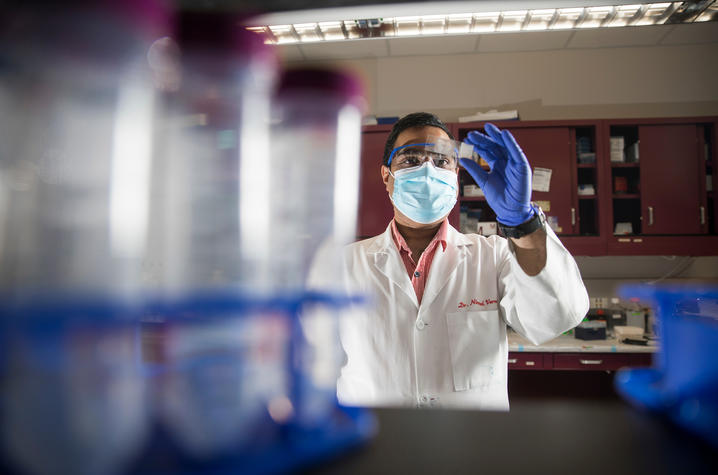ADAM: An Alliance Finding Treatments for Disorders Involving Microvascular Dysfunction
Photo caption: Nirmal Verma, PhD, a member of ADAM, working on a study potentially linking low blood amylin levels to reduced progression of Alzheimer’s disease. Photo by Pete Comparoni | UKphoto
For Florin Despa, PhD, and Larry Goldstein, MD, the University of Kentucky’s Alliance Research Initiative provided an avenue to collaborate on research they had wanted to pursue together for years in order to help improve the health of Kentuckians.
Dr. Despa, professor in the department of pharmacology and nutritional sciences, has dedicated 12 years to researching the role of microvascular dysfunction in Alzheimer’s disease. Dr. Goldstein, chair of neurology, is an expert on stroke and cerebrovascular disorders. Thanks to the Alliance Research Initiative, Dr. Despa and Dr. Goldstein combine their expertise with researchers across the college and University to find solutions to the related health issues Kentuckians face.
Together, they lead the Alliance for Reduction of Diabetes Associated Microvascular Dysfunction (ADAM), a team of scientists and physicians working to find new treatments of disorders involving microvascular dysfunction, a condition that causes the small blood vessels to work poorly, which reduces blood flow to the heart, brain, and other parts of the body.
The ADAM team is looking at the disparity between glycemic control and the microvascular complications of diabetes, which if left untreated, can lead to other serious illnesses such as Alzheimer’s disease and stroke. The team’s focus is on a possible link among these conditions – amylin, a hormone co-secreted with insulin and known to form pancreatic amyloid in patients with type-2 diabetes. Their published data show that amyloid-forming amylin secreted from the pancreas can line blood vessel walls and potentially lead to stroke.
“If we could figure out how to block amylin deposition or remove the amylin from the vessel wall, you could potentially decrease the risk of stroke,” Dr. Goldstein said. “If we eventually figure out a way to reduce stroke risk in this population, we also improve cognitive thinking outcomes like from Alzheimer’s disease in a very high-rate and a very high-risk population.”
To learn more ADAM has launched clinical trials, one of which is determining whether there is a correlation between the amylin level in the red blood cells and neuropathies in diabetes. An effect of microvascular dysfunction in type-2 diabetes is a painful condition called peripheral neuropathy, defined as damage to the nerves outside the brain and spinal cord. In a trial led by John Slevin, MD, MBA, ADAM researchers are working to discover if the level of amylin is related to the severity of this condition.
Another clinical trial, funded by National Institute of Neurological Disorders and Stroke (NINDS), is looking at the relationship between the level of amylin in the blood, in cerebrospinal fluid and dementia. The ADAM team is determining if a pattern is in place – whether the amylin equation in small blood vessels in the skin correlates with the amylin equation in the brain microvasculature.
“If that hypothesis holds true, then we could be able to enhance the capability of diagnosing cerebrovascular disease,” Dr. Despa said. “We can look at any level or amylin-related disease, look at the skin capillaries, and it’s pretty much indicative of a risk of stroke.”
The Alliance Research Initiative is supported by the UK College of Medicine, UK HealthCare, and the UK Vice President for Research. Thanks to its teamwork approach, the initiative has not only allowed for the enhancement of research and a more efficient process for obtaining important grant funding, but also the developing of junior faculty who will be able to build on this research in the future.
“What the Alliance does is first help get a group together on campus that is working in this area,” Dr. Goldstein said. “But, as importantly, and this is one of the major goals of the program, is also to provide a mechanism for young investigators, particularly young clinicians, to partner with basic translational scientists and develop a viable research area that will bleed to their independent funding.”
To learn more about ADAM and other Alliance teams, visit https://med.uky.edu/alliance.
ADAM Alliance Team Members:
- Ahmed Abdel-Latif, PhD, Associate Professor – Department of Internal Medicine
- Saurav Das, MD, - Assistant Professor, Department of Neurology
- Florin Despa, PhD, Professor – Department of Pharmacology and Nutritional Sciences
- Sanda Despa, PhD, Associate Professor – Department of Pharmacology and Nutritional Sciences
- Justin Fraser, MD, Associate Professor – Department of Neurosurgery
- Larry Goldstein, MD, Chair and Professor – Department of Neurology
- Louis Hersh, PhD, Professor – Department of Molecular and Cellular Biochemistry
- Gregory A Jicha, MD, Professor – Department of Neurology and Sanders-Brown Center on Aging
- Paul Murphy, PhD, Associate Professor – Department of Molecular and Cellular Biochemistry
- Nada Porter, PhD, Chair, Associate Professor, Department of Pharmacology and Nutritional Sciences
- Vlad Radulescu, MD, Associate Professor – Department of Pediatrics
- Aurelia Radulescu, MD, Associate Professor – Department of Pediatrics
- Susan Smyth, MD, PhD, Division Chief – Department of Internal Medicine
- Nirmal Verma, PhD, Assistant Professor – Department of Pharmacology
